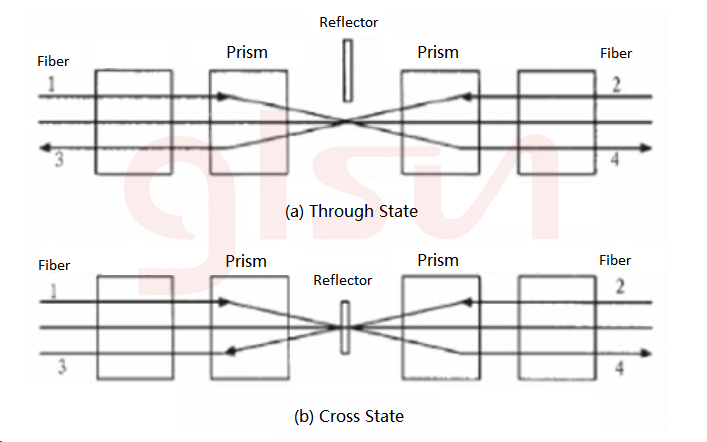Fiber Optic Switch is a device with one or more selected transmission windows that can perform mutual conversion or logical operation on optical signals in optical transmission lines or integrated optical circuits. The basic form of optical switch is 2x2, that is, every input port and output port have two optical fibers, which can complete two connection states, parallel connection and cross connection. The large space optical switch unit can be composed of the combination of a basic 2x2 and 1x2 fiber optic switch.

Optical switches play an important role in optical networks. In Wavelength Division Multiplexing (WDM) transmission systems, optical switches can be used for wavelength driving, regeneration and clock extraction. In Optical Time Division Multiplex (OTDM) system, optical switches can be used for demultiplexing; in all-optical switching systems, optical switches are key components of Optical Cross-connect (OXC), and are also important components for wavelength conversion. The number of input and output ports of the switch can be divided into 1×1, 1×2, 1×N, 2×2, 2×N, M×N, etc. They have different uses in different occasions. They can be widely used in protection switching system of optical network, light source control in optical fiber testing, real-time monitoring system of network performance, testing of optical devices, construction of switching core of OXC equipment, optical add/drop multiplexing, optical testing, optical Sensing systems, etc.
Main Types of Fiber Optic Switches
At present, the most widely used ones are still 1×2 and 2×2 mechanical optical switches. Traditional opto-mechanical optic switches can directly couple light to the output end through moving optical fibers, use prisms and reflectors to switch light paths, and send or reflect light directly to the output end.
There are three main types of mechanical optical switches: one uses prism switching light path technology, the other uses mirror switching technology, and the third uses moving optical fiber to switch the light path. The optical fiber is connected to the lens (collimator) that plays a collimating role and is fixed. The optical path between the input and port output is changed by moving the prism. When the reflector does not enter the light path, the optical switch is in a straight-through state. The light entering from fiber 1 enters fiber 4, and the light entering from fiber 2 enters fiber 3. When the reflector is at the intersection of the two light rays, the optical switch is in the intersection state. , the light entering fiber 1 enters fiber 3, and the light entering fiber 2 enters fiber 4 to achieve optical path switching. The mobile optical fiber optical switch is an optical fiber with fixed ends. The device at the other end of the mobile device is connected to different ports of the fixed device to realize switching of optical paths. This type of optical switch has low return loss and is greatly affected by ambient temperature. There is no real switching product.

The advantages of mechanical optical switches are low insertion loss (<1dB), high isolation (>45dB), independent of wavelength and detour, and mature production technology. Faced with the total switching action time (ms), the size is relatively large, and it is not suitable for large-scale foreign optical switch matrices, and sometimes there are problems of rebound and poor repeatability. Mechanical optical switches have been widely used in recent years. However, as the scale of optical networks continues to expand, this type of switch is difficult to adapt to the future development needs of high-speed and large-capacity optical transmission networks.
Micro-electro-mechanical System (MEMS) Optical Switches
Microelectronic mechanical optical switches have developed rapidly in recent years. They are a new type of micro-electro-optical integrated switch produced by combining semiconductor micro-processing technology with micro-optical and micro-mechanical technologies. It is a new type of switch for large-capacity switching optical networks. The mainstream direction of switch development.
MEMS(Micro Electro-Mechanical System) optical switches are carved into a number of tiny lenses on a silicon crystal. Through the action of electrostatic force or electromagnetic force, the movable mirrors can be raised, lowered, rotated or moved, thereby changing the propagation direction of the input light to realize the function of optical path on/off. MEMS optical switches have obvious advantages over other optical switches. The switching time is measured in microseconds. MEMS fiber optic switch adopts IC manufacturing technology, is small in size and highly integrated. The working method has nothing with the format, protocol, wavelength, transmission direction, matrix direction, and modulation of the optical signal. It can process optical signals of any wavelength. Besides, it has the advantages of low insertion loss, low crosstalk, low polarization sensitivity, high extinction ratio, high switching speed, small size, and easy large-scale integration.
According to functions, MEMS optical switches can be divided into optical path bias type, moving fiber contact type and mirror reflection type. Mirror reflection type MEMS optical switches are easy to integrate and control, and can easily form an optical switch array. They are the focus of MEMS optical switch research. They can be divided into 2D MEMS optical switches and 3D MEMS optical switches. The concept of 1D MEMS fiber optic switches is also proposed. The so-called 2D means that the movable mirror and fiber are located on the same plane, and the mirror is either on or off at any specified moment. In this mode, the mirror array is connected to N input fibers and M output fibers. The number of mirrors required for an N×N matrix optical switch is N². Therefore this method is also called N² structure scheme.